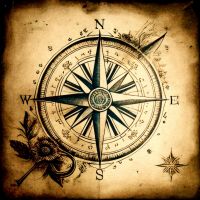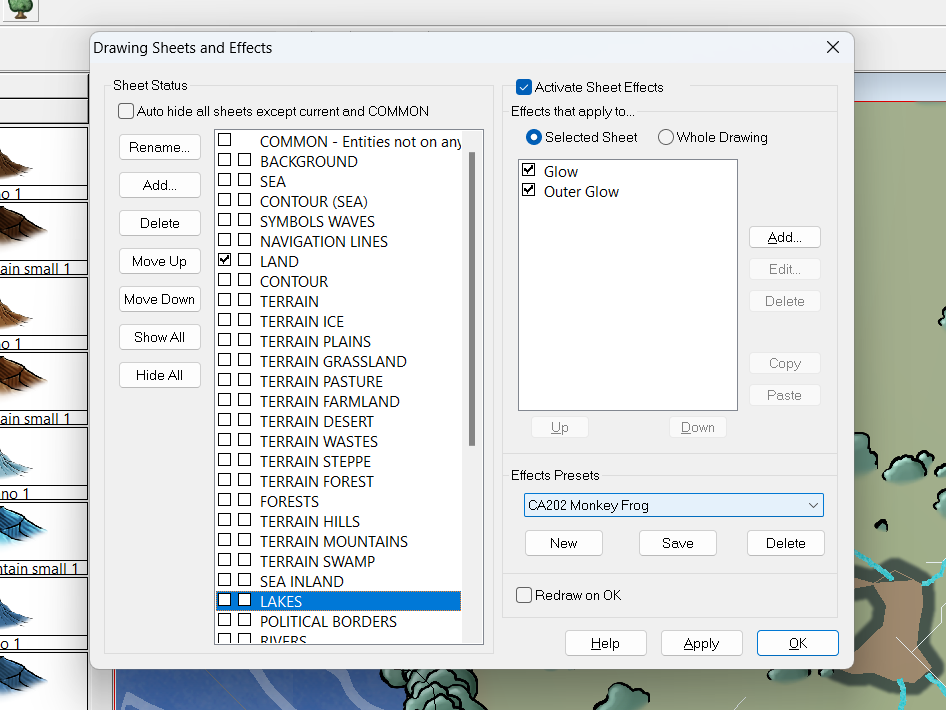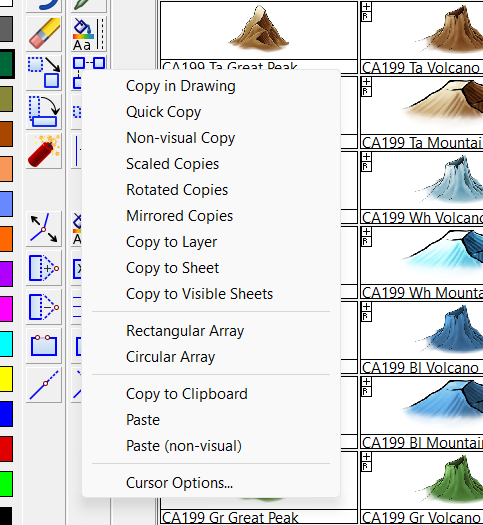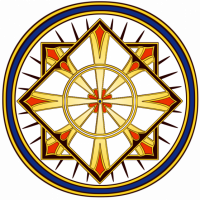Royal Scribe
Royal Scribe
About
- Username
- Royal Scribe
- Joined
- Visits
- 8,806
- Last Active
- Roles
- Member
- Points
- 3,198
- Birthday
- February 5, 1968
- Location
- San Francisco, California
- Real Name
- Kevin
- Rank
- Mapmaker
- Badges
- 16
Reactions
-
Issue with beach on Spectrum Overland
-
Drawing lakes over forests and mountains sheets with 2023 MonkeyFrog Overland style
So, it looks like your lake is drawn on the LAKES sheet, but you want it to cut all the way down to the sea?
You have a couple of choices.
Option 1: Don't have your lake cut down to the sea. Instead, change it to a blue color, or the same fill as the sea, and let it sit on top of the other terrain.
Option 2: If you want it to cut through, you will need to:
- Add the COLOR KEY effect to the LAKES sheet and move it to be the first effect.
- Change the color of your drawn lake to be the magenta color (#6)
- Make sure all of the other sheets between the lake and the sea also have the Color Key effect added as the first effect.
- And then, copy that magenta lake to all of the other sheets.
If you want to copy it to all of the intervening terrain sheets, the easiest way is to hide all sheets, then unhide the LAKES sheet and everything between it and the SEA, and then use the Copy to All Visible Sheets option (found by right-clicking on the Copy icon) to simultaneously copy it on all of those terrain sheets.
Please let me know if this is unclear, and I can try to do more screencaptures.
-
Can't seem to draw backgrounds
-
First Time Mapper, First Time Poster, Long Time Struggling Learner
Welcome, Matthew!
I agree wholeheartedly with Ricko's recommendation to start with Joe Sweeney's videos. I owned the software for many years, trying to teach myself how to use it through the PDF manuals and fiddling around with it, but could not make any sense of it. I would peek at this Forum and admire everyone's beautiful maps, but could not make any sense of the software. Then I stumbled across Joe's videos and everything clicked.
Joe's videos are old, but still relevant and give a good foundation for the software. Once you've watched those ones, I would recommend checking out more videos here:
https://forum.profantasy.com/discussion/10519/video-tutorials/p1
The viewing order of those videos that I think may be most helpful (in order to get a foundation before tackling more advanced subjects):
- Joe Sweeney
- Dogtag's and Josh Plunkett's
- Learning CC3+ Section
- Quickies
- Campaign Cartographer Concepts
The ones in the section called "Blog Videos" accompany a blog article on the same topic, so I would recommend tracking down those blog posts. And the ones under the Live Tutorial section are fantastic, but most are not focused on a single technique or tool, and some are more advanced than others. I would try to get a good grounding from the other videos first, and then consider the older Live videos before the newer ones unless you see one on a specific topic that you think will be helpful. The Live videos are also really enlightening about the possibilities with the range of add-ons.
I resisted watching the videos for a long time because I was impatient and thought I could read the PDFs faster than watching a video. And that clearly didn't work for me: I bought the software in 2017 and didn't start watching the videos until mid/late-2023, and didn't make any maps until then either. But honestly, watching really made everything fall into place for me. Plus, I just love seeing someone start with a blank canvass and bring it to life to become a work of art. It's like watching Bob Ross painting videos. I've not only learned techniques from the Live videos, I've also been creatively inspired by them, too.
-
Missing Fill and Castles Failure






